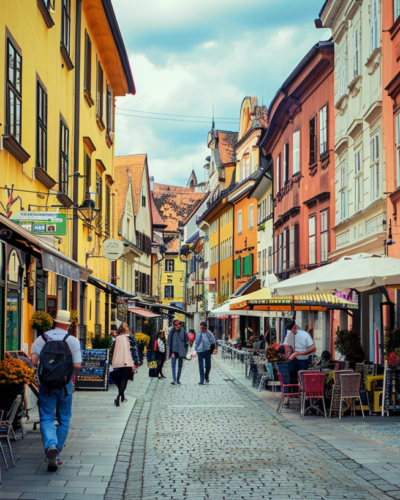Standing at the crossroads of history and innovation, one can hear the echoes of the past meet the vision of the future. This is the essence of the Hiroshima Peace Memorial— a masterpiece born from Kenzo Tange’s legacy, serving as a testament to the country’s resilience, peace, and architectural brilliance.

Nestled within the vibrant cityscape of Hiroshima, a poignant edifice stands as a testament to the resilience of the human spirit and the transformative capacity of thoughtful design. The Hiroshima Peace Memorial is a creation of visionary architect Kenzo Tange, that emerges as a symbol of rebirth in a landscape once marred by the ravages of conflict. This emblematic structure draws countless visitors each year, drawn by its compelling narrative of recovery and the promise of peace.
Kenzo Tange’s legacy and architectural masterpiece, with its harmonious blend of traditional Japanese elements and modernist innovation, not only reshapes the urban fabric of Hiroshima but also leaves a lasting imprint on the global architectural community.
The memorial’s profound significance extends beyond its physical form as it also serves as a critical juncture where the lessons of history and the aspirations for a peaceful future converge. Through Tange’s work, we are offered a unique lens into the role of architecture in narrating and shaping the collective memory and identity of a society poised on the cusp of new beginnings.
Without a doubt, the Hiroshima Peace Memorial stands not just as a reminder of what was lost, but as a beacon of hope and a call to action towards a world marked by understanding and unity.
Kenzo Tange’s Legacy: Mastermind Behind Modernist Marvels
Kenzo Tange’s architectural brilliance shines not just in Hiroshima but across Japan in general. His modernist marvels stand as landmarks of innovation and beauty.
In Tokyo, the Yoyogi National Gymnasium, with its sweeping curves and daring structure, hosted the 1964 Olympics and continues to captivate visitors with its futuristic silhouette. Meanwhile, the Kagawa Prefectural Government Office in Takamatsu epitomizes Tange’s ability to blend functionality with aesthetic appeal. Its clean lines and use of natural light reflects a harmony between environment and edifice.
Each creation in Kenzo Tange’s legacy invites travelers to explore the depths of Japan’s architectural heritage, offering a journey through spaces that narrate stories of cultural resilience and visionary design. The architect’s work extends beyond individual buildings, influencing urban design and the architectural profession itself. His philosophy painstakingly blends modernist ideals with traditional Japanese elements to foster a unique architectural dialogue that encourages a fusion of the past with futuristic visions. Kenzo Tange’s legacy reminds us all of architecture’s potential to reflect and shape cultural identity, making his sites not just places to visit but experiences that connect deeply with the soul of Japan.

Hiroshima’s Beacon: More Than Just a Memorial
Our featured architectural marvel, the Hiroshima Peace Memorial Park, with the Atomic Bomb Dome at its heart, is more than just your typical memorial. It’s truly a profound symbol of peace and human endurance. As visitors walk through the park, past the Children’s Peace Monument and the serene Peace Memorial Museum, they are enveloped in a mixed narrative that tells of sorrow, strength, and hope. This sacred space, amidst the bustling city life of Hiroshima, stands as a reminder of the country’s past while also being a beacon for a future where peace prevails. The park’s thoughtful design and poignant monuments make it a must-visit destination for those seeking to connect with the deeper human stories behind historical events.
Unsurprisingly, the Peace Memorial presents a profound space for reflection, serving as a catalyst for conversations about war, peace, and the future of humanity. Its existence in Hiroshima— a city that has flourished into a vibrant hub of culture and life, symbolizes the incredible capacity for recovery and the importance of remembering history to forge a peaceful path forward. It’s a place that transcends its physical boundaries, becoming a global symbol of hope for everyone.
Architectural Genius: The Blueprint of Peace
In designing the Hiroshima Peace Memorial, Kenzo Tange’ legacy was stamped in history as he crafted more than just another structure. Tange was able to create a symbol of revival and peace. His innovative use of materials and light, along with the integration of natural elements like water and greenery, speak to a design philosophy that transcends the traditional boundaries of architecture.
Truly, Tange’s work at Hiroshima invites contemplation and reflection, offering a space where architecture and memory can harmoniously converge. The landmark serves as a testament to the power of design in healing and reconciliation, making it a pivotal point of interest for other architects, historians, and peace advocates.
As Tange’s architectural approach in Hiroshima clearly demonstrated how physical spaces can contribute to healing and peace, the thoughtful integration of symbolic elements within the Memorial’s design also offers a silent yet powerful narrative on the impact of war and the universal desire for peace. It stands as a testament to architecture’s role not just in building structures, but in crafting messages and emotions that resonate across generations.

Tange’s Influence: Shaping Skylines and Minds
Kenzo Tange’s legacy extends beyond the borders of Hiroshima, shaping urban landscapes and architectural thought around the world. His approach to city planning and architectural design has mainly inspired generations of architects to consider the socio-cultural implications of their work. From the bustling streets of Tokyo to the serene landscapes of Osaka, Tange’s legacy can be seen in the skylines he helped shape and in the minds he inspired. His work encourages a dialogue on the role of architecture in societal development and cultural identity, making his buildings more than just structures, but landmarks of thought and innovation.
The legacy of Kenzo Tange is also evident in the way modern architects approach the integration of cultural elements into their designs, especially in spaces meant for remembrance and community. His influence encourages a thoughtful consideration of how spaces interact with their historical and cultural contexts, inspiring architects to create buildings that are not only functional but meaningful.
Hiroshima Today: A Lesson in Resilience and Hope
Today, Hiroshima stands as a vibrant city with streets that prove to be testaments to the resilience of its people and the transformative power of vision. With its blend of historical sites like the Peace Memorial Park and modern attractions like the bustling Hondori Street and the verdant Shukkeien Garden, the city offers a unique tapestry of experiences. Of course, Hiroshima‘s journey from devastation to rejuvenation is a compelling narrative of hope, making it an essential destination for those looking to understand the impact of history on the human spirit and the enduring quest for peace.
While the Peace Memorial Park, amidst this bustling city life, stands as a poignant reminder of Hiroshima‘s history and resilience, Its transformation transcends architecture, showcasing a vibrant culture— from its delicious cuisine to its lush gardens and lively streets. It’s a city that embodies the possibility of a new beginning, making it a profound destination for all who visit.

Embracing Peace Through Architectural Wonder
Kenzo Tange’s legacy endures right in the heart of Hiroshima, not just in concrete and steel, but in the spirit of hope and reconciliation that the Hiroshima Peace Memorial embodies. This architectural marvel serves as a poignant bridge between a past marked by tragedy and a future oriented towards peace and unity. Tange’s vision, deeply rooted in the essence of resilience and renewal, invites us to reflect on the transformative power of architecture as a medium for healing and hope.
As we conclude this exploration, let us carry forward Hiroshima’s message and testament that reflects the strength of the human spirit and the enduring quest for peace. May we all be inspired to contribute to a world where understanding and compassion triumph over conflict and despair.
Visit Hiroshima and witness the legacy of Kenzo Tange with thiscityknows.com and be a part of the ongoing quest towards a more peaceful tomorrow.








